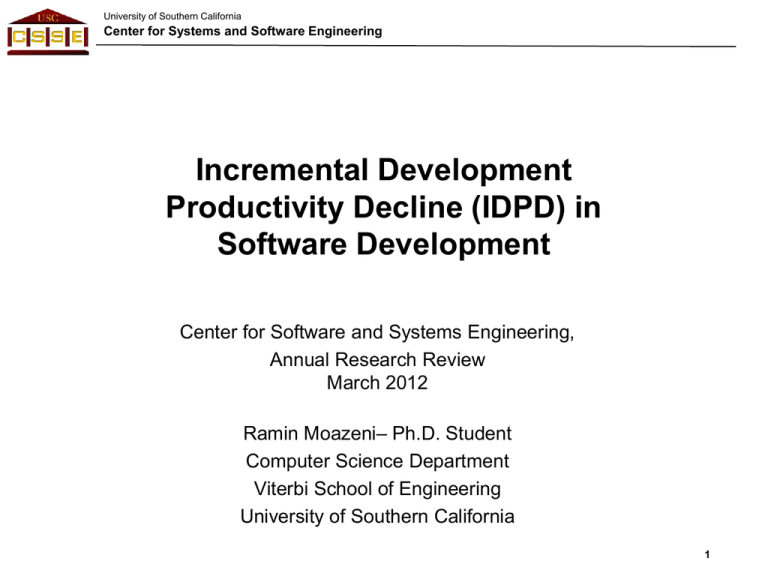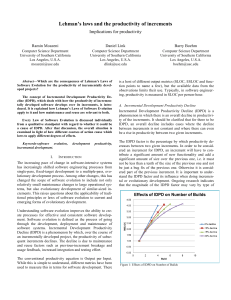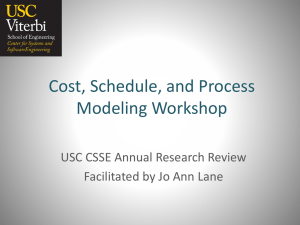Incremental Development Productivity Decline (IDPD)
advertisement

University of Southern California Center for Systems and Software Engineering Incremental Development Productivity Decline (IDPD) in Software Development Center for Software and Systems Engineering, Annual Research Review March 2012 Ramin Moazeni– Ph.D. Student Computer Science Department Viterbi School of Engineering University of Southern California 1 University of Southern California Center for Systems and Software Engineering Outline • Incremental Development Productivity Decline (IDPD) – – – – Overview Relevant Examples Cost Drivers Effect on number of increments 2 University of Southern California Center for Systems and Software Engineering Incremental Development Productivity Decline (IDPD) • Overview – The “Incremental Productivity Decline” (IDPD) factor represents the percentage of decline in software producibility from one increment to the next. – The decline is due to factors such as previous-increment breakage and usage feedback, increased integration and testing effort. – Another source of productivity decline is that maintenance of reused previous build software is not based on equivalent lines of software credited during the previous build, but on the full amount of reused software. • Build 1: 200 KSLOC new, 200K Reused@20% yields a 240 K ESLOC “count” for estimation models. • Build 2: there are 400 KSLOC of Build 1 to maintain and integrate – Such phenomena may cause the IDPD factor to be higher for some builds and lower for others. 3 University of Southern California Center for Systems and Software Engineering Incremental Development Productivity Decline (IDPD) • Example: Site Defense BMD Software – 5 builds, 7 years, $100M – Build 1 productivity over 300 SLOC/person month – Build 5 productivity under 150 SLOC/person month • Including Build 1-4 breakage, integration, rework • 318% change in requirements across all builds • A factor of 2 decrease across 4 builds corresponds to an average build to build IDPD factor of 20% productivity decrease per build – Similar IDPD factors have been found for: • Large commercial software such as multi-year slippage in delivery of MS Word for Windows and Windows Vista. 4 University of Southern California Center for Systems and Software Engineering Quality Management Platform (QMP) Project • QMP Project Information: – Web-based application – System is to facilitate the process improvement initiatives in many small and medium software organizations – 6 builds, 6 years, different increment duration – Size after 6th build: 548 KSLOC mostly in Java – Average staff on project: ~20 5 University of Southern California Center for Systems and Software Engineering Quality Management Platform (QMP) Project • Data Collection – Most data come from release documentation, build reports, and project member interviews/surveys – Data include product size, effort by engineering phase, effort by engineering activities, defects by phase, requirements changes, project schedule, COCOMO II driver ratings (rated by project developers and organization experts) – Data collection challenges: • Incomplete and inconsistency data • Different data format, depends on who filled the data report • No system architecture documents available 6 University of Southern California Center for Systems and Software Engineering Quality Management Platform (QMP) Project Data Analysis – Productivity Trends Productivity Trend Build Size (KSLOC) Effort (PH) Productivity (SLOC/PH) Productivity Variance 1 69.12 7195 9.61 0.0% 2 64 9080 7.05 -26.6% 8.00 6.00 3 19 6647 2.86 -59.4% 4 39.2 8787.5 4.46 56.1% 5 207 31684.5 6.53 46.5% 6 65 16215.1 4.01 -38.6% 12.00 10.00 9.61 7.05 6.53 4.46 4.00 4.01 2.86 2.00 0.00 0 1 2 3 4 5 6 Builds Productivity Linear (Productivity) Table 1 • The slope of the trend line is -0.76 SLOC/PH per build • Across the five builds, this corresponds to a 14% average decline in productivity per build. This is smaller than the 20% Incremental Development Productivity Decline (IDPD) factor observed for a large defense program • Most likely because the project is considerably smaller in system size and complexity 7 7 University of Southern California Center for Systems and Software Engineering Causes of IDPD Factor Explorations of the IDPD factors on several projects, the following sources of variation were identified: Higher IDPD (Less Productive) Lower IDPD (More Productive) Effort to maintain previous increment; bug fixing, COTS upgrades, interface changes Next increment requires previous increment modification Next increment spun out to more platforms Next increment has more previous increments to integrate/interact with Next increment touches less of the previous increment Staff turn over reduces experience Current staff more experienced, productive Next increment software more complex Next increment software less complex Previous increment incompletely developed, tested, integrated Previous increment did much of the next increment’s requirements, 8 architecture University of Southern California Center for Systems and Software Engineering Software Categories & IDPD Factor • Categorization of different type of software with different productivity curves through multiple build cycles, require different IDPD factors applicable to each class of software. Software Category Impact on IDPD Factor Non-Deployable Throw-away code. Low Build-Build integration. High reuse. IDPD factor lowest than any type of deployable/operational software Infrastructure Software Often the most difficult software. Developed early on in the program. IDPD factor likely to be the highest. Application Software Builds upon Infrastructure software. Productivity can be increasing, or at least “flat” Platform Software Developed by HW manufacturers. Single vendor, experienced staff in a single controlled environment. Integration effort is primarily with HW. IDPD will be lower due to the benefits mentioned above. Firmware (Single Build) IDPD factor not applicable. Single build increment. 9 University of Southern California Center for Systems and Software Engineering IDPD Model & Data Definition • Based on analysis of the IDPD effects, the next increment’s ESLOC, IDPD factor, and software effort can be estimated – KSLOC (I) in the existing increments 1 through I • The fraction F of these are going to be modified – The previous increments (I) would then be considered as reused software and their equivalent lines of code calculated as • EAF (I+1): EAF factor for the next increment’s development EAF (I+1) would be the EAF (I) adjusted by the product of Delphi-TBD effort multipliers for the following IDPD factors: IDPD Drivers Description RCPLX Complexity of Increment I+1 relative to complexity of existing software IPCON Staff turnover from previous increment’s staff PRELY Previous increments’ required reliability IRESL Architecture and risk resolution (RESL) rating of I+1 relative to RESL of 1..I 10 University of Southern California Center for Systems and Software Engineering IDPD Model & Data Definition - 2 • The total EKSLOC(I+1) = EKSLOC (I) + EKSLOC (I+1 Added) and the EAF (I+1) factor would be used in the standard COCOMO II equations to compute PM (I+1). EKSLOC (I) = KSLOC (I) * (0.4*DM + 0.3*CM + 0.3*IM) • The standalone PM for Increment I+1, SPM (I+1), would be calculated from EKSLOC (I+1 Added) and EAF (I), using the standard COCOMO II equations. • The IDPD (I+1) factor would then be IDPD(I+1) = SPM (I+1) / PM (I+1) 11 University of Southern California Center for Systems and Software Engineering Data Collection • Collect data of completed Incremental projects from industry • Inclusion Criteria: – Starting and ending dates are clear – Has at least two increments of significant capability that have been integrated with other software (from other sources) and shown to work in operationally-relevant situations – Has well-substantiated sizing and effort data by increment – Less than an order of magnitude difference in size or effort per increment – Realistic reuse factors for COTS and modified code – Uniformly code-counted source code – Effort pertaining just to increment deliverables 12 University of Southern California Center for Systems and Software Engineering Data Collection - 2 • Metrics Metric Description Product Name of software product Build Build number. A software product that has multiple builds (increments) Effort Total time in person-hours New SLOC SLOC count of new modules Reused SLOC SLOC count of reused modules COTS SLOC SOLC count of COTS modules CM The percentage of modified code DM The percentage of design modified IM The percentage of implementation and test needed for the reused/COTS modules SU Software Understanding UNFM Programmer Unfamiliarity Cost drivers Rating levels for 22 cost drivers 13 University of Southern California Center for Systems and Software Engineering Preliminary Results - 1 • Delphi Results – 2 rounds of Delphi at CSSE and ISCAS IDPD Factor Productivity Range Variance RCPLX 1.79 0.098 IPCON 1.77 0.066 PRELY 1.49 0.029 IRESL 1.53 0.029 14 University of Southern California Center for Systems and Software Engineering Preliminary Results - 2 • IDPD Driver ratings VL L N H VH PRELY 0.972 0.986 1 1.008 1.025 RCPLX 0.985 0.904 1 0.783 0.732 IPCON 0.841 0.900 1 0.951 1.052 IRESL 1.065 1.046 1 0.988 0.933 15 University of Southern California Center for Systems and Software Engineering Preliminary Results - 3 • Relative Impact of Cost drivers on Effort: Productivity Ranges CPLX PCON RESL RELY 0 0.2 0.4 0.6 0.8 1 1.2 1.4 1.6 1.8 16 University of Southern California Center for Systems and Software Engineering Question? 17











